Appeals Process, Recognised Prior Learning, Special Needs
This document provides information on the appeals process, recognized prior learning, special needs, and assessment requirements for the BSBINN601 course. It also includes case studies for the course.
31 Pages7068 Words245 Views
Added on 2022-12-27
About This Document
This document provides information on the appeals process, recognised prior learning, and special needs in assessment requirements. It explains the importance of analysing organisational objectives and reviewing existing policies. It also helps identify external trends and events that impact organisational objectives. Additionally, it discusses major operational change requirements due to performance gaps, business opportunities, or threats.
Appeals Process, Recognised Prior Learning, Special Needs
This document provides information on the appeals process, recognized prior learning, special needs, and assessment requirements for the BSBINN601 course. It also includes case studies for the course.
Added on 2022-12-27
ShareRelated Documents
.1
appeals process
If you feel that you have been unfairly treated during your assessment, and you are not happy
with your assessment and/or the outcome as a result of that treatment, you have the right to
lodge an appeal. You must first discuss the issue with your trainer/assessor. If you would like to
proceed further with the request after discussions with your trainer/assessor, you need to lodge
your appeal to the course coordinator, in writing, outlining the reason(s) for the appeal.
Recognised prior learning
Candidates will be able to have their previous experience or expertise recognised on request.
Special needs
Candidates with special needs should notify their trainer/assessor to request any required
adjustments as soon as possible. This will enable the trainer/assessor to address the identified
needs immediately.
Assessment requirements
Assessment can either be:
appeals process
If you feel that you have been unfairly treated during your assessment, and you are not happy
with your assessment and/or the outcome as a result of that treatment, you have the right to
lodge an appeal. You must first discuss the issue with your trainer/assessor. If you would like to
proceed further with the request after discussions with your trainer/assessor, you need to lodge
your appeal to the course coordinator, in writing, outlining the reason(s) for the appeal.
Recognised prior learning
Candidates will be able to have their previous experience or expertise recognised on request.
Special needs
Candidates with special needs should notify their trainer/assessor to request any required
adjustments as soon as possible. This will enable the trainer/assessor to address the identified
needs immediately.
Assessment requirements
Assessment can either be:
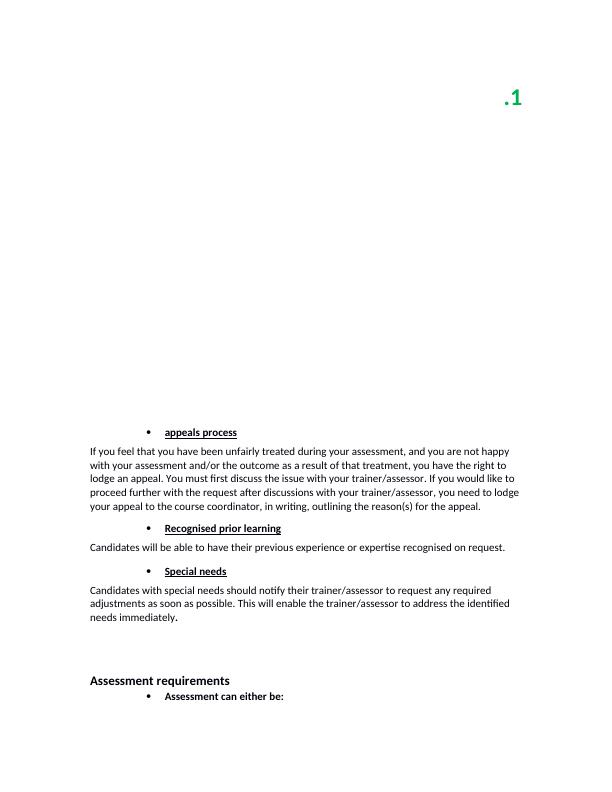
Direct observation
Product-based methods e.g. reports, role plays, work samples
Portfolios – annotated and validated
Questioning
Third party evidence.
If submitting third party evidence, the Third Party Observation/Demonstration document must
be completed by the agreed third party.
Third parties can be:
Supervisors
Trainers
Team members
Clients
Consumers.
The third party observation must be submitted to your trainer/assessor, as directed.
The third party observation is to be used by the assessor to assist them in determining
competency.
The assessment activities in this workbook assess aspects of all the elements, performance
criteria, skills and knowledge and performance requirements of the unit of competency.
To demonstrate competence in this unit you must undertake all activities in this workbook and
have them deemed satisfactory by the assessor. If you do not answer some questions or
perform certain tasks, and therefore you are deemed to be Not Yet Competent, your
trainer/assessor may ask you supplementary questions to determine your competence. Once
you have demonstrated the required level of performance, you will be deemed competent in
this unit.
Should you still be deemed Not Yet Competent, you will have the opportunity to resubmit your
assessments or appeal the result.
As part of the assessment process, all learners must abide by any relevant assessment policies as
provided during induction.
If you feel you are not yet ready to be assessed or that this assessment is unfair, please contact
your assessor to discuss your options. You have the right to formally appeal any outcome and, if
you wish to do so, discuss this with your trainer/assessor.
Product-based methods e.g. reports, role plays, work samples
Portfolios – annotated and validated
Questioning
Third party evidence.
If submitting third party evidence, the Third Party Observation/Demonstration document must
be completed by the agreed third party.
Third parties can be:
Supervisors
Trainers
Team members
Clients
Consumers.
The third party observation must be submitted to your trainer/assessor, as directed.
The third party observation is to be used by the assessor to assist them in determining
competency.
The assessment activities in this workbook assess aspects of all the elements, performance
criteria, skills and knowledge and performance requirements of the unit of competency.
To demonstrate competence in this unit you must undertake all activities in this workbook and
have them deemed satisfactory by the assessor. If you do not answer some questions or
perform certain tasks, and therefore you are deemed to be Not Yet Competent, your
trainer/assessor may ask you supplementary questions to determine your competence. Once
you have demonstrated the required level of performance, you will be deemed competent in
this unit.
Should you still be deemed Not Yet Competent, you will have the opportunity to resubmit your
assessments or appeal the result.
As part of the assessment process, all learners must abide by any relevant assessment policies as
provided during induction.
If you feel you are not yet ready to be assessed or that this assessment is unfair, please contact
your assessor to discuss your options. You have the right to formally appeal any outcome and, if
you wish to do so, discuss this with your trainer/assessor.
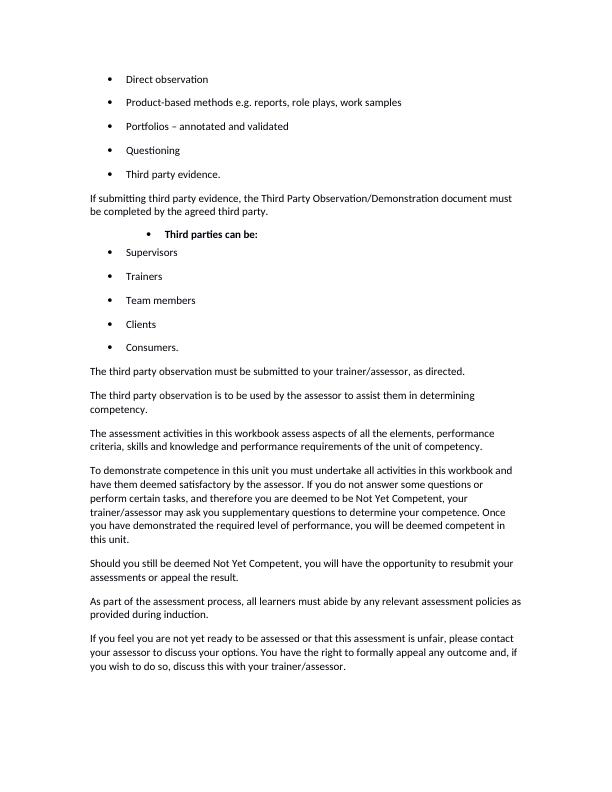
Observation/Demonstration
Throughout this unit, you will be expected to show your competency of the elements through
observations or demonstrations. Your trainer/assessor will have a list of demonstrations you
must complete or tasks to be observed. The observations and demonstrations will be completed
as well as the activities found in this workbook.
An explanation of observations and demonstrations:
Observation is on-the-job
The observation will usually require:
Performing a work based skill or task
Interaction with colleagues and/or customers.
Demonstration is off-the-job
A demonstration will require:
Performing a skill or task that is asked of you
Undertaking a simulation exercise.
Your trainer/assessor will inform you of which one of the above they would like
you to do. The observation/demonstration will cover one of the unit’s
elements.
The observation/demonstration will take place either in the workplace or the
training environment, depending on the task to be undertaken and whether it
is an observation or demonstration. Your trainer/assessor will ensure you are
provided with the correct equipment and/or materials to complete the task.
They will also inform you of how long you have to complete the task.
You should be able to demonstrate the skills, knowledge and performance criteria required for
competency in this unit, as seen in the Learner Guide.
Third Party Guide
You should supply details of the third party to the assessor before you commence the activities
(see below), unless the assessor has already selected a third party themselves. The assessor can
then contact the third party in instances where they require more evidence to determine
competency, or they cannot observe certain tasks themselves.
The reasons to use a third party may include:
Throughout this unit, you will be expected to show your competency of the elements through
observations or demonstrations. Your trainer/assessor will have a list of demonstrations you
must complete or tasks to be observed. The observations and demonstrations will be completed
as well as the activities found in this workbook.
An explanation of observations and demonstrations:
Observation is on-the-job
The observation will usually require:
Performing a work based skill or task
Interaction with colleagues and/or customers.
Demonstration is off-the-job
A demonstration will require:
Performing a skill or task that is asked of you
Undertaking a simulation exercise.
Your trainer/assessor will inform you of which one of the above they would like
you to do. The observation/demonstration will cover one of the unit’s
elements.
The observation/demonstration will take place either in the workplace or the
training environment, depending on the task to be undertaken and whether it
is an observation or demonstration. Your trainer/assessor will ensure you are
provided with the correct equipment and/or materials to complete the task.
They will also inform you of how long you have to complete the task.
You should be able to demonstrate the skills, knowledge and performance criteria required for
competency in this unit, as seen in the Learner Guide.
Third Party Guide
You should supply details of the third party to the assessor before you commence the activities
(see below), unless the assessor has already selected a third party themselves. The assessor can
then contact the third party in instances where they require more evidence to determine
competency, or they cannot observe certain tasks themselves.
The reasons to use a third party may include:
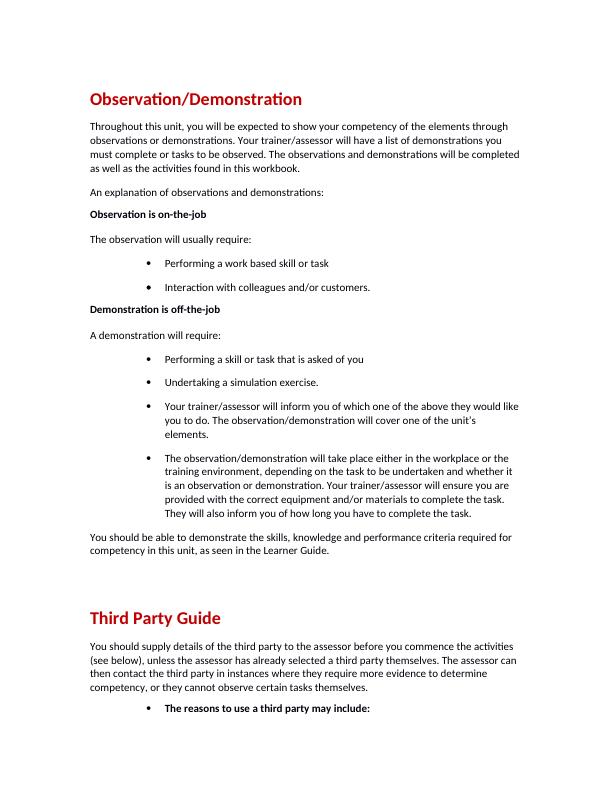
Assessment is required in the workplace
Where there are health and safety issues related to observation
Patient confidentiality and privacy issues are involved.
If you are not employed, or able to complete demonstrative tasks in the workplace, you will
need to inform the assessor. They will be able to provide you with a simulated environment in
which to complete these tasks.
We would prefer that, wherever possible, these be “live” issues for your industry and require
application of the principles that you are learning as part of your training. Where this is not
possible, you and your third party should simulate the activity tasks and demonstrations that
you believe would be likely to arise in your organisation or job role.
Third party evidence can also be used to provide “everyday evidence” of tasks included in your
work role that relate to the unit of competency but are not a part of the formal assessment
process.
The third party is not to be used as a co-assessor – the assessor must make the final decision on
competency themselves.
Documents relevant to collection of third party evidence are included in the Third Party section
in the Observations/Demonstrations document.
Third party details (required information from the learner)
A third party may be required for observations or demonstrations; please provide details below
of your nominated third party and obtain their signature to confirm their agreement to
participate. This information will be required by your trainer/assessor in advance of arranging
any future observations or demonstrations.
Third party name:
Position of third party:
Telephone number:
Email address:
Declaration for nominated third party
I declare my intention to act as third party for (learner’s name here)
Third party signature: Date:
Activities
Complete the following activities individually or in a group (as applicable to the specific
activity and the assessment environment).
Where applicable, a signed observation by either an approved third party or the assessor will
need to be included in these activities as proof of completion.
Where there are health and safety issues related to observation
Patient confidentiality and privacy issues are involved.
If you are not employed, or able to complete demonstrative tasks in the workplace, you will
need to inform the assessor. They will be able to provide you with a simulated environment in
which to complete these tasks.
We would prefer that, wherever possible, these be “live” issues for your industry and require
application of the principles that you are learning as part of your training. Where this is not
possible, you and your third party should simulate the activity tasks and demonstrations that
you believe would be likely to arise in your organisation or job role.
Third party evidence can also be used to provide “everyday evidence” of tasks included in your
work role that relate to the unit of competency but are not a part of the formal assessment
process.
The third party is not to be used as a co-assessor – the assessor must make the final decision on
competency themselves.
Documents relevant to collection of third party evidence are included in the Third Party section
in the Observations/Demonstrations document.
Third party details (required information from the learner)
A third party may be required for observations or demonstrations; please provide details below
of your nominated third party and obtain their signature to confirm their agreement to
participate. This information will be required by your trainer/assessor in advance of arranging
any future observations or demonstrations.
Third party name:
Position of third party:
Telephone number:
Email address:
Declaration for nominated third party
I declare my intention to act as third party for (learner’s name here)
Third party signature: Date:
Activities
Complete the following activities individually or in a group (as applicable to the specific
activity and the assessment environment).
Where applicable, a signed observation by either an approved third party or the assessor will
need to be included in these activities as proof of completion.
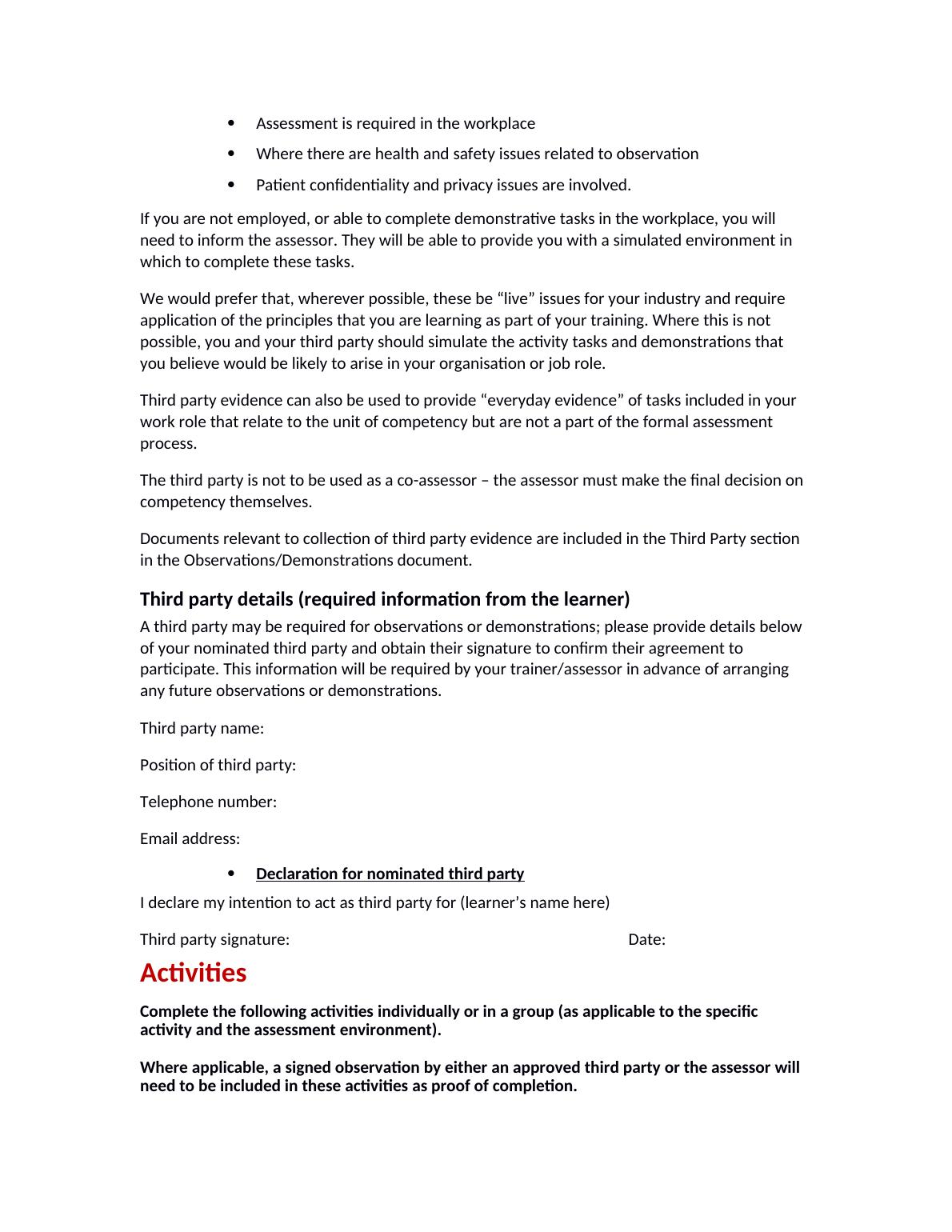
Activity 1A
Estimated Time 10 Minutes
Objective To provide you with an opportunity to identify strategic change needs through
an analysis of organisational objectives.
Activity Complete the following individually or in a group (as applicable to the specific
activity and the assessment environment):
Why is it important to analyse an organisation’s objectives when identifying
change requirements or opportunities?
Give three examples of the types of strategic change that may be required
as a result of an analysis of organisational objectives.
Why is it important to analyse an organisation’s objectives when identifying
change requirements or opportunities?
Considering current markerting environmnet of the business
enviornment, anlysing aims and objectives of a business enterprises
plays an important role for bringing in changes in policies and
strategies of the operational firm. It helps management departmnet
of the respective firm to operate effectively ensuring completion of
desired objectives of the firm with effective utilisation of valuable
resources of the business firm.
Give three examples of the types of strategic change that may be required
as a result of an analysis of organisational objectives.
Three examples of types of strategic change that might be required
as a result of an analysis of organisational objectives:
Adaptation: can be accommodated with the existing culture and can
occur incrementally.
Reconstruction: rapid change but without fundamentally changing the
culture
Revolution: fundamental changes in both strategy and culture.
Estimated Time 10 Minutes
Objective To provide you with an opportunity to identify strategic change needs through
an analysis of organisational objectives.
Activity Complete the following individually or in a group (as applicable to the specific
activity and the assessment environment):
Why is it important to analyse an organisation’s objectives when identifying
change requirements or opportunities?
Give three examples of the types of strategic change that may be required
as a result of an analysis of organisational objectives.
Why is it important to analyse an organisation’s objectives when identifying
change requirements or opportunities?
Considering current markerting environmnet of the business
enviornment, anlysing aims and objectives of a business enterprises
plays an important role for bringing in changes in policies and
strategies of the operational firm. It helps management departmnet
of the respective firm to operate effectively ensuring completion of
desired objectives of the firm with effective utilisation of valuable
resources of the business firm.
Give three examples of the types of strategic change that may be required
as a result of an analysis of organisational objectives.
Three examples of types of strategic change that might be required
as a result of an analysis of organisational objectives:
Adaptation: can be accommodated with the existing culture and can
occur incrementally.
Reconstruction: rapid change but without fundamentally changing the
culture
Revolution: fundamental changes in both strategy and culture.

Activity 1B
Estimated Time 10 Minutes
Objective To provide you with an opportunity to review existing policies and practices
against strategic objectives to identify where changes are required.
Activity Complete the following individually or in a group (as applicable to the specific
activity and the assessment environment):
Why should existing policies and practices be reviewed against strategic
objectives?
Imagine that an organisation has a new strategic objective concerning the
introduction of new technology throughout the business which will affect all
employees. Which types of policies and practices may need to be reviewed
in the light of this objective?
Why should existing policies and practices be reviewed against strategic
objectives?
There is a greater importance of regulary reviewing and monitoring up of
performances being produced by various staffs working in an orgnaisation
with contast to current external policies and practises existing in current
business environment. Various strategic objectives of the firm are being
introduced every financial year by respective business firm, managers and
leaders of the firm should keep a regular check on such strategic objectives
and examine their relevance with current trending policies or practise being
followed by the giverning body of that region.
Imagine that an organisation has a new strategic objective concerning the
introduction of new technology throughout the business which will affect all
employees. Which types of policies and practices may need to be reviewed
in the light of this objective?
With light to, respective strategic objective determined by a business firm
for introducing new technology which will directly or indirectly impact in
employee performance. Various policies and practises which needs to
reviewed here are;
Behavious of employees working in an organisation.
Availablity of technical means in respective operational area of the
business, wherein business firm is operating.
Support in terms of governent policies with regards to chosen
technological strategy of the company.
Estimated Time 10 Minutes
Objective To provide you with an opportunity to review existing policies and practices
against strategic objectives to identify where changes are required.
Activity Complete the following individually or in a group (as applicable to the specific
activity and the assessment environment):
Why should existing policies and practices be reviewed against strategic
objectives?
Imagine that an organisation has a new strategic objective concerning the
introduction of new technology throughout the business which will affect all
employees. Which types of policies and practices may need to be reviewed
in the light of this objective?
Why should existing policies and practices be reviewed against strategic
objectives?
There is a greater importance of regulary reviewing and monitoring up of
performances being produced by various staffs working in an orgnaisation
with contast to current external policies and practises existing in current
business environment. Various strategic objectives of the firm are being
introduced every financial year by respective business firm, managers and
leaders of the firm should keep a regular check on such strategic objectives
and examine their relevance with current trending policies or practise being
followed by the giverning body of that region.
Imagine that an organisation has a new strategic objective concerning the
introduction of new technology throughout the business which will affect all
employees. Which types of policies and practices may need to be reviewed
in the light of this objective?
With light to, respective strategic objective determined by a business firm
for introducing new technology which will directly or indirectly impact in
employee performance. Various policies and practises which needs to
reviewed here are;
Behavious of employees working in an organisation.
Availablity of technical means in respective operational area of the
business, wherein business firm is operating.
Support in terms of governent policies with regards to chosen
technological strategy of the company.
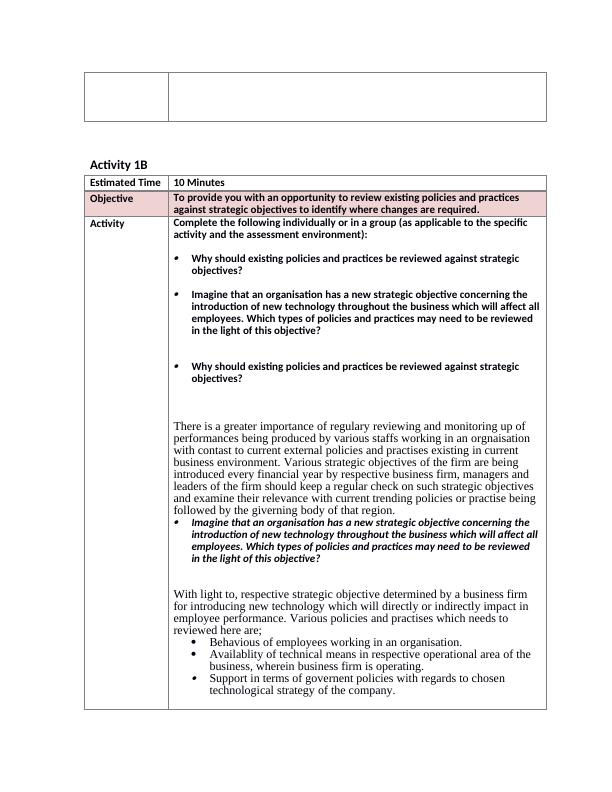
Activity 1C
Estimated Time 20 Minutes
Objective To provide you with an opportunity to monitor the external environment to
identify events or trends that impact on the achievement of organisational
objectives.
Activity Complete the following individually or in a group (as applicable to the specific
activity and the assessment environment):
Give six examples of the types of external trends or events that may impact
the achievement of an organisation’s objectives.
Using the PESTLE analysis tool, identify three current factors in each
category which affect (or may potentially affect) your industry sector. Give six examples of the types of external trends or events that may impact
the achievement of an organisation’s objectives.
Changes in government policies in legislation
Technology develooment changes
Changes in Intrest rates
Social media changes
Estimated Time 20 Minutes
Objective To provide you with an opportunity to monitor the external environment to
identify events or trends that impact on the achievement of organisational
objectives.
Activity Complete the following individually or in a group (as applicable to the specific
activity and the assessment environment):
Give six examples of the types of external trends or events that may impact
the achievement of an organisation’s objectives.
Using the PESTLE analysis tool, identify three current factors in each
category which affect (or may potentially affect) your industry sector. Give six examples of the types of external trends or events that may impact
the achievement of an organisation’s objectives.
Changes in government policies in legislation
Technology develooment changes
Changes in Intrest rates
Social media changes

Increase in competitors activities
Labour resources environmental developments
Using the PESTLE analysis tool, identify three current factors in each
category which affect (or may potentially affect) your industry sector.
PESTLE Current factors
Political Employment laws, Tax policy,
Contract laws.
Environmental Social objectives, waste and
recycling.
Sociological Culture norms, career plan and age
group.
Technological Internet technology, social media,
innovation.
Legal Taxation system, Employment,
Contract act.
Economical Inflation/Deflation rates, investment
rates.
Give six examples of the types of external trends or events that may impact
the achievement of an organisation’s objectives.
Labour resources environmental developments
Using the PESTLE analysis tool, identify three current factors in each
category which affect (or may potentially affect) your industry sector.
PESTLE Current factors
Political Employment laws, Tax policy,
Contract laws.
Environmental Social objectives, waste and
recycling.
Sociological Culture norms, career plan and age
group.
Technological Internet technology, social media,
innovation.
Legal Taxation system, Employment,
Contract act.
Economical Inflation/Deflation rates, investment
rates.
Give six examples of the types of external trends or events that may impact
the achievement of an organisation’s objectives.

End of preview
Want to access all the pages? Upload your documents or become a member.
Related Documents
BSBMKG605 Evaluate International Marketing Opportunitieslg...
|42
|5401
|57
BSBADM502 Manage Meetings Learner Workbooklg...
|25
|4631
|187
Corporate Social Responsibility Learner Workbooklg...
|34
|5170
|433
BSBINN601 Lead and Manage Organisational Change Learner Workbooklg...
|20
|4016
|495
BSBRSK501 Manage Risk Learner Workbooklg...
|40
|6208
|276
BSBHRM509: Manage Rehabilitation or Return to Work Programslg...
|40
|6348
|150
